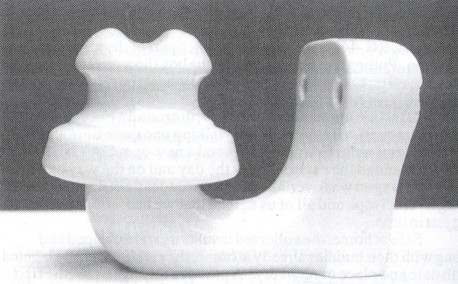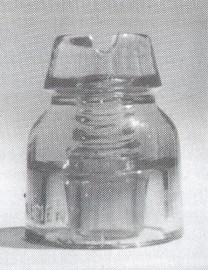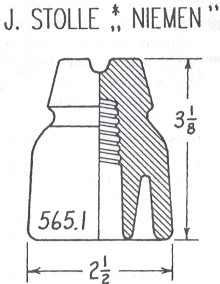Foreign Insulators
by Marilyn Albers
Reprinted from "Crown Jewels of the Wire", December 1994, page 10
LEAVE IT TO GERMAN INGENUITY!
In the spring of 1990, when Editor Carol McDougald and I went on an insulator
research trip to Europe, we visited Marco Schimitz-LeHanne in Krefeld, Germany.
An example of the strange looking insulator you see here was in Marco's
collection. When I first saw it, I was tempted to find a big stick and kill it!
But he assured us that it was indeed an insulator and actually quite rare.
Unfortunately he had only the one and it was not for trade, so we took a few photos and
left it behind. There was no drawing made of the piece at that time, and
consequently no U-number assigned, but it definitely left an impression on us.

U-2294A

Not long ago, a good collector friend of mine told me he had received one of
these insulators in a shipment from Europe but was not particularly interested in it, so we made a
deal and it's now in my collection. I was fortunate, indeed. The unit measures
7" across at the widest part and stands 4-7/8" high. Being a solid
piece of porcelain, it weighs just under 3-1/2 lbs. Not something you'd want to
drop on your toes! Its unglazed base provided a perfectly flat firing surface or
"rest" when it was fired in the kiln. The 'AB' trademark on the crown
indicates that the insulator was manufactured in Germany by PORZELLAN-INDUSTRIE-AG
BERGHAUS, in the city of Auma, Thuringia (a division of Germany).
This company was established in 1909 and produced insulators for both low and
high tension as well as dry process electroceramics. After World War II, it sent
huge quantities of low voltage insulators of the type RM II to the USSR as war
reparations. The factory still exists, producing oxide ceramics, but the name
has been changed to VEB PORZELLANWERK AUMA.
When Marco came to Houston for the
1994 Silver Anniversary of the NIA National Show this past July, he spotted this
insulator on my shelf. I asked him why it had been made all in one piece
together with its "stalk" and bracket. He explained that since Germany
is a small country surrounded by land on all sides, it has no sea ports of its
own. During World War II, the Allied Naval Blockade cut off many of Germany's imports, including metal,
which was badly needed for bullets, guns and tanks. Fashioning insulators, pins,
and brackets into one porcelain unit eliminated the need for metal hardware. The
curved bracket with its two 3/8" holes made it possible to bolt the
insulator directly onto the utility pole. So this design was a matter of
necessity and German ingenuity certainly came to the rescue!
Elton Gish and I
consulted at great length over where this unique piece should be placed in the
Universal Style Chart. Since the basic style of the insulator (minus stalk and
bracket) has already been classified as U-2294, we decided the combined unit
should be U- 2294A, figuring that's probably where Jack Tod would have put it.
Foreign insulators certainly do come in all sizes and shapes! That's what makes
them so interesting.
ANOTHER NEW CD NUMBER - 565.1
This little fellow was found in Poland. It measures 2-1/2" wide at the
base and stands 3-1/4" high. It is the exact same shade of aqua as found in
many other styles of Polish glass insulators. The style is similar to several
other foreign glass types that have already been catalogued, but still enough different to warrant a new CD number. At the present
time, we know of only this one specimen, but would be glad to hear from our
readers if there are others out there. The embossing is what makes this
insulator exciting as well as frustrating, because we don't know what it means.
I wrote Miroslav Immer in Prague, Czech Republic, our expert on European
insulator manufacturers. After some research, he did find that there was a
wholesale company in Poland called J. STOLLE, but it had been out of business
since 1939 and he wasn't able to determine what products they had offered. To
further confuse the issue, the word "STOLLE" is German and means
Christmas cake! And while there was no town in either Poland or Germany called
NIEMEN, there was one in Russia, which became part of Lithuania after 1945
(Lithuania is known for its glass works). Yet the insulator was found in Poland.
My head is spinning! So if anyone can shed some light on our mystery insulator,
please let me know.


|
